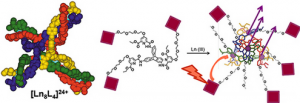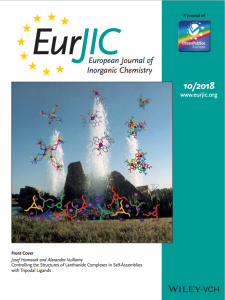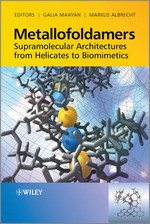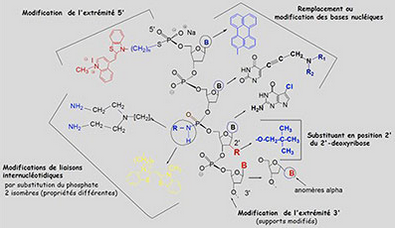Research theme
Research activities of the group are mainly focused on design, synthesis and characterization of molecular and supramolecular systems of varied complexity. We are interested in a better understanding of structural factors, intra- and intermolecular interactions, thermodynamic and kinetic equilibria within these assemblies or mixtures, and their exploiting for biomedical applications and imaging, nanomaterials and cosmetics. Our approach is interdisciplinary and requires competences in chemistry, biochemistry and biophysics. Few research subjects are presented in more details below, but the list is non-exhaustive. If you would be interested in joining us (at any level: student, researcher, etc.), don’t hesitate to contact us. Actual information can be found at the group website.
If you wish to collaborate with us or join us at the laboratory (trainee level, engineer, researcher, etc.), we will be delighted to welcome you.
On the other hand, if you wish to use the services of the spectroscopic facility of the CBM, do not hesitate to contact us.
Self-assembled polymetallic complexes
Polynuclear compounds with lanthanides can be advantageously prepared using a supramolecular synthetic approach. The preparation of self-assembled stable systems, where many factors must be taken into account, is not an easy task. In this context, an effort has been made in the design and synthesis of suitable ligands to provide and characterize precursors (polytopic ligands and their complexes) for different applications. Detailed thermodynamic speciation studies of supramolecular complexes with different lanthanide cations are carried out by NMR and different spectroscopic methods (Functionalized Triptycene-Derived Tripodal Ligands : Privileged Formation of Tetranuclear Cage Assemblies with Larger Ln(III). Inorg. Chem. (2017) 56, 2742-2749 - doi : 10.1021/acs.inorgchem.6b02900 - Vuillamy A., Zebret S., Besnard C., Placide V., Petoud S. and Hamacek J.). Between the most important achievements we can highlight the self-assembly of octanuclear helicates Ln8L4 (Designing Artificial 3D helicates: unprecedented self-assembly of Homo-octanuclear Tetrapods with Europium Chem. Eur. J. 2015, 21, 6695-6699 - doi : 10.1002/chem.201500006 - Dr. Soumalia Zebret, Eliane Vögele, Dr. Tomas Klumper, Prof. Josef Hamacek)

The majority of our ligands are so-called “tripods” (tripodal ligands), which can form, in principle, Ln(III) complexes of different structure and nuclearity. (Understanding the Speciation of Ln(III) complexes with octadentale tripodal ligands - New J.chem (2017) 41, 4390-4399 - doi : 10.1039/C7NJ00088j - El Aroussi B. and Hamacek J.)
 Recently, we have published a review article about this subject in the European Journal of Inorganic Chemistry
Recently, we have published a review article about this subject in the European Journal of Inorganic Chemistry
(Controlling the structure of lanthanide complexes in self-assemblies with tripodal ligands - European Journal of Inorganic Chemistry (2018) 2018 (10) 1155-1166. - doi : 10.1002/ejic.201800108 - Hamacek J. and Vuillamy A. )
 The thermodynamic principles of self-assemblies with lanthanides have been discussed in details in the book “Metallofoldamers : Supramolecular Architectures
The thermodynamic principles of self-assemblies with lanthanides have been discussed in details in the book “Metallofoldamers : Supramolecular Architectures
from Helicates to Biomimetics.”
(Eds. : Albrecht M. and, Maayan G., Wiley 2013).
Enzymatic Kinetics in Complex Media
This work is carried out in collaboration with Francesco Piazza and his group. We study enzymatic (but not only) reactions in different complex media reminiscent to biological/cellular environments. These may interact with active components and significantly influence reaction rates or pathways. The interactions are investigated with appropriate biophysical methods involving a synchrotron radiation facility (SOLEIL).
Hybrid bio-assemblies
Here, our interest is focused on the preparation of biologically active assemblies using “chemical anchors”. This approach allows a better control of topology and specificity of such systems. Their applications in biological targeting or imaging are multiple and are currently under exploration.
Modified oligonucleotides

Novel families of original oligonucleotides have been recently developed to provide tools for basic research, in vitro diagnostics, biological imaging, and potential therapeutic agents. Depending on applications, the oligonucleotides must possess several of the following properties: forming specific and stable complexes with their targets, inducing irreversible modifications of the targets by bridging or cleavage, producing a modified signal in the presence of targets that can be used as evidence interaction. Moreover, in the case of applications in cell culture and in vivo, they must be stable towards nucleases and be capable of reaching their targets inside cells (J. Gene Med. 2014, 16, 157-165). In order to confer specific properties to the oligonucleotides for targeted applications, we chemically modify their structural elements (nucleic bases, sugars, inter-nucleotide linkages (length and nature)). To these oligonucleotides may be attached various ligands: intercalating and/or reactive molecules, peptides, lipophilic molecules, inhibitors, detectable fluorescent markers.
